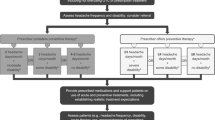Abstract
The availability of many over-the-counter drugs that were formerly prescription medications enable patients with migraine to self-medicate easily and delay entry into the appropriate medical management. The potential for adverse effects, drug interactions, and analgesic rebound headaches can often be complications that hinder treatment. Over-the-counter products force the patient to employ a less effective step-care approach as opposed to evidence-based guidelines.
Similar content being viewed by others
References and Recommended Reading
Silberstein SD: Practice parameter: evidence-based guidelines for migraine headache: an evidence-based review. Neurology 2000, 55:754–762. Utilizes an evidence-based consensus review to make recommendations for migraine diagnosis and management.
Silberstein SD, Lipton RB, Dalessio DJ: Wolff’s Headache and Other Head Pain. Edited by Silberstein SD, Lipton RB, Dalessio DJ. New York: Oxford University Press; 200l.
Bajwa ZH, Sabahat A: Pathophysiology, clinical manifestations, and diagnosis of migraine headache. Available at http:/ /www.uptodateonline.com. Accessed November 25, 2001.
Aurora SK: Pathophysiology of migraine headache. Pain Headache 2001, 5:179–182.
Goadsby PJ: Current concepts of the pathophysiology of migraine. In Neurologic Clinics. Edited by Mathew NT. Philadelphia: WB Saunders; 1997, 15:27–44.
Goadsby PJ: Pathophysiology of headache. In Wolff’s Headache and Other Head Pain. Edited by Silberstein SD, Lipton RB, Dalessio DJ. New York: Oxford University Press; 2001:57–72.
Lipton RB, Diamond S, Reed M, et al.: Migraine diagnosis and treatment: results from the American Migraine Study II. Headache 2001, 41:638–645. Identifies results of two large epidemiologic migraine surveys in the US population, including trends of diagnosis and treatment.
Sheftell FD: Role and impact of over-the-counter medications in the management of headache. In Neurologic Clinics. Edited by Mathew NT. Philadelphia: WB Saunders; 1997, 15:187–198.
Matcher DB, Young WB, Rosenberg JH, et al.: Evidence-based guidelines for migraine headache in the primary care setting: pharmacologic management of acute attacks. The US Headache Consortium. 2000. Available at http:/www.aan.com. In depth review of acute therapy recommendations for migraine management.
Lipton RB, Baggish JS, Stewart WF, Codispoti JR: Efficacy and safety of acetaminophen in the treatment of migraine. Arch Intern Med 2000, 160:3486–3492.
Catella-Lawson F, Reilly MP, Kapoor SC, et al.: Cyclooxygenase inhibitors and the antiplatelet effects or aspirin. N Engl J Med 2001, 345:1809–1817.
Saper JR: Drug overuse among patients with headache. In Neurologic Clinics. Edited by Packard RC. Philadelphia: WB Saunders; 1983:1:465–477.
Pittler MH, Vogler BK, Ernst E: Feverfew for preventing migraine. Cochrane Database Syst Rev 2001, 2:1–10.
Palevitch D, Earon G, Carusso RL: Feverfew (Tanacetum parthenium) as a prophylactic treatment for migraine. Phytother Res 1997, 11:508–511.
Johnson ES, Kadam NP, Hylands DM, Hylands JP: Efficacy of feverfew as prophylactic treatment of migraine. Br Med J 1985, 291(6495):569–673.
Murphy JJ, Heptinstall S, Mitchell JR: Randomized doubleblind placebo-controlled trial of feverfew in migraine prevention. Lancet 1988, 2(8604):189–192.
deWeerdt CJ, Tootsma HP, Hendriks H: Herbal medicines in migraine prevention: randomized double-blind placebocontrolled crossover trial of feverfew preparation. Phytomedicine 1996, 3:225–230.
Micromedex R Healthcare Series: MICROMEDEX, Greenwood Village, Colorado (Edition expires March 3, 2002).
Mauskop A: Alternative therapies in headache: is there a role? Med Clin North Am 2001, 85(4):1077–1084.
Silberstein S, Lipton R, Goadsby P: Chronic daily headache: diagnosis and treatment. In Headache in Clinical Practice. Edited by Silberstein S, Lipton R, Goadsby P. Oxford: Isis Medical Media Ltd; 1998:101–114. Discusses medication misuse in relationship to appropriate identification and treatment of rebound headaches and contributions to chronic daily headache.
Matthew NT: Transformed migraine, analgesic rebound, and other chronic daily headaches. In Neurologic Clinics. Edited by Matthew NT. Philadelphia: WB Saunders; 1997, 15:167–186.
Warner JS: The outcome of treating patients with suspected rebound headache. Headache 2001, 41:685–692.
Sanchez del Rio M, Silberstein S: How to pick optimal acute treatment for migraine headache. Pain Headache 2001, 5:170–178.
Hu XH, Markson LE, Lipton RB, et al.: Burden of migraine in the United States: disability and economic costs. Arch Inter Med 1999, 159:813–818.
Lipton RB, Stewart WF, Von Korff M: The burden of migraine: a review of cost to society. Pharmacoeconomics 1994, 3:215–221.
Schweitzer SO: The economics of migraine. Am J Manag Care 1999, 5(Suppl 2):S91-S98.
Rapoport AM, Adelman JU: Cost of migraine management: a pharmacoeconomic overview. Am J Manag Care 1998, 4:531–545.
Legg RF, Sclar DA, Nemec NL, et al.: Cost-effectiveness of sumatriptan in a managed care population. Am J Manag Care 1997, 3:117–122.
Solomon GD, Cady RK, Klapper JA, et al., on behalf of the 042 Clinical Trial Study Group: Clinical efficacy and tolerability of 2.5 mg zolmitriptan for the acute treatment of migraine. Neurology 1997, 49:1219–1225.
Adelman JU, Sharfman M, Johnson R, et al.: Impact of oral sumatriptan in workplace productivity, health-related quality of life, healthcare use, and patient satisfaction with medication in nurses with migraine. Am J Manag Care 1996, 2:1407–1416.
Cady RC, Ryan R, Jhingran P, et al.: Sumatriptan injection reduces productivity loss during a migraine attack: results of a double-blind, placebo-controlled trial. Arch Intern Med 1998, 158:1013–1018.
Lofland JH, Johnson NE, Batenhorst AS, Nash DB: Changes in resource use and outcomes for patients with migraine treated with sumatariptan: a managed care perspective. Arch Intern Med 1999, 159:857–863.
Author information
Authors and Affiliations
Rights and permissions
About this article
Cite this article
Tonore, T.B., King, D.S. & Noble, S.L. Do Over-the-counter medications for migraine hinder the physician?. Current Science Inc 6, 162–167 (2002). https://doi.org/10.1007/s11916-002-0014-9
Issue Date:
DOI: https://doi.org/10.1007/s11916-002-0014-9




